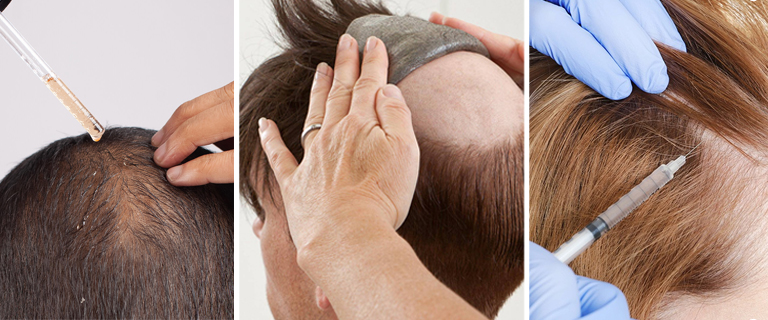Many of our patients aren’t always convinced about surgical hair transplant procedures. In such cases, we present our non-surgical hair replacement services to them and enable them to understand if it fits their needs. Of course, surgical hair restoration gives you the highest chance of getting natural-looking hair. But non-surgical hair restoration techniques can be economical, less invasive and adaptable.
Non-surgical hair restoration can be of two types. The first one usually involves supplements, shampoos, and other products to stop hair loss, in addition to hair loss drugs like minoxidil and finasteride. The second one is more familiar and specific. It describes a select group of hair replacement items worn on or applied to the scalp to restore hair loss due to male pattern baldness. These include various customised and off-the-shelf hair replacement “systems” and non-surgical treatments like scalp micropigmentation.
Restoring Hair Loss Through Non Surgical Procedures
PRP Injection Therapy Platelet-Rich Plasma injection or PRP injection therapy involves the extraction of a small sample of the patient’s blood for scalp treatment. Once the doctor extracts the blood sample, it is spun in a centrifuge to separate the platelets from the other blood components. This concentrated PRP solution is then injected repeatedly into the areas of the scalp that need it. This operation only takes a few minutes, and there is no recovery time afterwards, so the patient can return to their regular routine immediately. PRP injection therapy relies on the physiological activity of cytokines, a protein that supports hair growth and healing.
Hair Loss Control Medications The best non-surgical hair restoration method is by using FDA-approved medications such as Finasteride (Propecia) and Minoxidil(Rogaine). These medications are usually used in hair restoration procedures such as hair transplant surgery. However, for patients who are interested in an alternative to hair transplantation, these medications work just as well.
Rogaine extends the hair growth cycle when used daily on the scalp. Priority one is to stop more hair loss, which could take up to six months before the patient sees meaningful results. The most successful prescription hair loss treatment for men is Propecia because it works to suppress the synthesis of the male hormone dihydrotestosterone (DHT). DHT is a significant contributor to the development of male-pattern hair loss. After using Propecia for 12 to 18 months, clinical trials have indicated that up to 66% of men exhibit some hair regrowth.
Hair Replacement Systems
A hair replacement system (HRS) is a prosthetic device that replaces lost or damaged hair. The most common type of HRS is a hairpiece, which fits over the scalp and holds artificial hair in place. While some individuals wear HRS purely for cosmetic purposes, HRS is intended mainly for medical reasons, such as to fill bald patches. Hair replacement systems are commonly called wigs or toupées. Unlike the synthetic-looking, artificial wigs that most people associate with the word “toupée,” hair replacement systems vary widely in quality, with some virtually impossible to tell apart from real, natural hair.
Scalp Micropigmentation
Scalp Micropigmentation, or SMP, is a non-surgical technique that employs tiny, tattooed dots to simulate fuller hair. Although treatment doesn’t replace hair, micro pigmentation can conceal bald spots and mimic the appearance of thicker hair by placing dots on the scalp. Many different kinds of hair loss, including alopecia areata, scarring alopecias, and male pattern baldness, are attractively treated using micropigmentation.
LaserCap Treatment
Laser Cap Treatment is an FDA-approved non-surgical hair restoration procedure. The therapy enables hair strands to get thicker and live longer before they fall out. In the LaserCap procedure, specialised cells deep inside the hair follicles absorb red laser light, supplying energy to promote cellular repair and hair growth. The result is a general decrease in the look of hair thinning and a noticeable improvement in the quality of hair growth.
The Verdict
Among the many benefits of non-surgical hair replacement, the lower cost of hair restoration and immediate aesthetic improvement are the most important ones. With all the techniques listed above, you will look like you have a full head of hair again. But despite their efficiency, hair replacement systems and micro scalp pigmentation only prolong the life of hair strands destined to fall.
They don’t actually do anything to treat or prevent hair loss. By choosing non-surgical hair restoration methods, you will continue to lose hair. In many cases, you might even be able to grow back hair in areas where hair loss is significant. But the fact remains, none of these non-surgical methods of restoring hair is a replacement for FUE and FUT hair transplant procedures that assure 100%scalp hair restoration.
If you have questions about which hair transplant procedure is the best for you, fix an appointment to speak to our experts. We offer comprehensive consultation and counselling for patients who seek detailed information about surgical and non-surgical hair transplant methods.